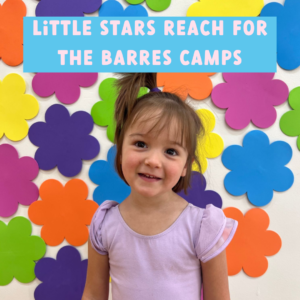
Our summers are jam packed with fun! You may know about all our fun themed camps for our elementary school aged students as well as our intensives for our older students… but did you know we have special days of fun for our smallest of dancer!
⭐️LITTLE STARS REACH FOR THE BARRES CAMPS⭐️
What are the LITTLE STAR CAMPS?
This super, fun three-day camp is the perfect introduction to dance for your tiniest dancer.Each day, your dancer will learn ballet and/or tap|tumble basics in a fun and positive environment. Meet new friends and have a dance-a-riffic time!👯♀️
Who are our little star camps for?⛺️
This camp is for our smallest of dancers and shakers. The ages rage to be approved is 2.5-3.5! We ask that your dancer tuned 2.5 by May 1st!
What’re the themes this summer?☀️
We have a handful of fun themes for your mover to enjoy this year! Let’s check them out below ⬇️
WEEK ONE: TINKERBELL’S TREASURE COVE🧚
Monday, June 19-21 | 4:00-4:45pm
WEEK TWO: TWINKLE + TWIRL’S PRINCESS PARTY👑
Monday, June 26-28 | 4:00-4:45pm
WEEK THREE: OLAF’S SNOWY SHUFFLE☃️
Monday, July 10-12 | 4:00-4:45pm
WEEK FOUR: ANIMAL CRACKERS ON PARADE🦁
Monday, July 17-19 | 4:00-4:45pm
WEEK FIVE: TUTTI FRUTTI TROPICAL CUTIES🍉
Monday, July 31st-Aug 2 | 4:00-4:45pm
WEEK SIX: RAINBOW DASH BIRTHDAY BASH🌈
Monday, Aug 7-9 | 4:00-4:45pm
What will my dancer need to enjoy the LITTLE STARS CAMP?
Your dancer won’t need much to fully enjoy these parties. All they truly need is a smile & some dancing shoes 🩰. We do ask that your dancer is also dressed in proper dance attire, shoes + pull hair up and out of the face, daily.

RFTB x Selah’s Winter Drive!
2023 End Of The Year
Well, here we are again. At the end of another year. In today’s blog post, we will not be discussing technique, hacks or career how-tos. Instead, today we are simply here to say “Thank you”, and last minutes things to help you transition into recital with ease!
After coming off of a year that was like no other, season 8 was truly great. We watched you all grow in talent and technique. Our studios are full of bright and shining up and coming stars. We couldn’t be more proud.
Within this season it truly felt like the dance world has made it back on it’s feet. Curtains are rising on recital stages once again with ease. We are entering year 2 of facing new normals, and we are so happy to have had you along for the ride. We have worked our way back up from virtual dance classes to full dance studios. It has been such a joy having yet another year moving forward with our Reach For The Barres family.
With all the joy and triumphs our year is winding down, and our recital is right around the corner. With that we are excited to announce, that it’s going to be a spectacular show! Our students have worked hard in the studio to make sure their dances look flawless and fun! We have no doubt in our minds about the magic you are going to see on stage.
To our parents, we are so thankful that you allow us here at Reach to teach your children the art of dance. We know there is much that comes with being a dance parent, and know you are doing your part in making sure your child has everything they need to shine on stage! We truly can’t say thank you enough for all you do to support your dancer and know it’s a lot to keep track of. To make your job a little easier, we thought we would give you a mini list of everything you need in your child’s dance bag to have a successful show day.
Read through the list below and pack your child’s bag before the big day. You will be able to check a few things off your list so you can enjoy the moment with your child!
All costumes labeled with your child’s name.
It’s SO important to label your costumes. The last thing you want is to be missing an accessory or shoe when it’s time to dance on stage! Your child’s things could get mixed up easily so it’s best to be safe and mark your child’s initials into all your costume items, shoes, and accessories. Please make sure to mark costumes and shoes on the inside so we don’t see them on stage. This is especially important for our dancers in multiple numbers.
Dance shoes
This seems obvious but it’s worth saying, there is nothing worse than missing a shoe on recital day! Make sure to have your dancer try on their shoes before the big day to catch any holes or shoes that are too tight. Need new shoes? Stop by the studio where you can buy anything you need for the big day.
Extra tights
We have provided your dancers with tights in their costume bag. But we all know that tights can rip easily! Throw in an extra pair of tights for your dancer along with the ones they will wear on stage. That extra pair could save the day for your dancer!
Costume accessories
Do any of your child’s costumes come with headpieces, layers, or other accessories? These items are just as important as your main costume to have in your dance bag.
Our summers are jam packed with fun! You may know about all our fun themed camps for our elementary school aged students as well as our intensives for our older students… and last week you heard all about our Little Stars Reach for the Barres Camps for smallest of dancers.. This week we’re going to dive into what we have for the movers and groovers that seem like an “in-between age”.
We have something for every dancer!
⭐️MINI SPARKLERS PRESCHOOL + KINDER CAMPS⭐️
What are the Mini Sparkler Camps?✨
All of these fun sized camps are loaded with joy! They will focus on multiple genres of dance and engage your petite dancer in a creative and lively setting! These festive + fancy camps are five-days of fantastical fun!
Who are our little star camps for?⛺️
These camps are for our petite dancers that are ready for more that our little star camps offer in 45 minutes, but aren’t ready to be thrown in with the bigger elementary school kids for the 8 hours camps. The ages rage to be approved is 3-6 years old!
How long is each camp?⌛️
Each week that we offer mini sparkler camps would be a 5 day event lasting 3 hours each day!
What’re the themes this summer?☀️
|WEEK ONE| Morning: DANCING WITH MY DOLLIE: THE LITTLE MERMAID🧜♀️
Monday, June 26 – 9:00 am – 12:00 pm 3h
|WEEK ONE| Afternoon: DANCING WITH MY DOLLIE: A FROZEN ADVENTURE❄️
Monday, June 26 – 1:00 pm – 4:00 pm 3h
|WEEK TWO | Morning: THE MAGICAL MADRIGALS🪕
Monday, July 10 – 9:00 am – 12:00 pm 3h
|WEEK THREE | Afternoon: DANCING WITH MY DOLLIE: LIFE INSIDE THE DREAMHOUSE (BARBIE)🎀
Monday, July 10 – 12:30 pm – 3:30 pm 3h
|WEEK FOUR| Morning: WELCOME TO THE CIRCUS (PRESCHOOL ACROBATICS MINI CAMP)🎪
Monday, July 24 – 9:00 am – 12:00 pm 3h
|WEEK FOUR | Morning: HAIR UP (TROLLS MAGIC)🦄
Monday, August 21 – 9:00 am – 12:00 pm 3h
What will my dancer need to enjoy the Mini sparkler camps?✨
Your dancer won’t need much to fully enjoy these events. All they truly need is a smile & some dancing shoes 🩰 along with being potty trained. We do recommend your dancer wears something they are comfortable to move in, dance shoes are optional, but hair should pulled up and out of the face, daily. We will be having snack time each day of camp a so bring your own water bottle and a NUT-FREE snack to enjoy! 🥨
Our summers are jam packed with fun! You may know about all our fun themed camps for our elementary school aged students as well as our intensives for our older students… but did you know we have special days of fun for our smallest of dancer!
⭐️LITTLE STARS REACH FOR THE BARRES CAMPS⭐️
What are the LITTLE STAR CAMPS?
This super, fun three-day camp is the perfect introduction to dance for your tiniest dancer.Each day, your dancer will learn ballet and/or tap|tumble basics in a fun and positive environment. Meet new friends and have a dance-a-riffic time!👯♀️
Who are our little star camps for?⛺️
This camp is for our smallest of dancers and shakers. The ages rage to be approved is 2.5-3.5! We ask that your dancer tuned 2.5 by May 1st!
What’re the themes this summer?☀️
We have a handful of fun themes for your mover to enjoy this year! Let’s check them out below ⬇️
WEEK ONE: TINKERBELL’S TREASURE COVE🧚
Monday, June 19-21 | 4:00-4:45pm
WEEK TWO: TWINKLE + TWIRL’S PRINCESS PARTY👑
Monday, June 26-28 | 4:00-4:45pm
WEEK THREE: OLAF’S SNOWY SHUFFLE☃️
Monday, July 10-12 | 4:00-4:45pm
WEEK FOUR: ANIMAL CRACKERS ON PARADE🦁
Monday, July 17-19 | 4:00-4:45pm
WEEK FIVE: TUTTI FRUTTI TROPICAL CUTIES🍉
Monday, July 31st-Aug 2 | 4:00-4:45pm
WEEK SIX: RAINBOW DASH BIRTHDAY BASH🌈
Monday, Aug 7-9 | 4:00-4:45pm
What will my dancer need to enjoy the LITTLE STARS CAMP?
Your dancer won’t need much to fully enjoy these parties. All they truly need is a smile & some dancing shoes 🩰. We do ask that your dancer is also dressed in proper dance attire, shoes + pull hair up and out of the face, daily.